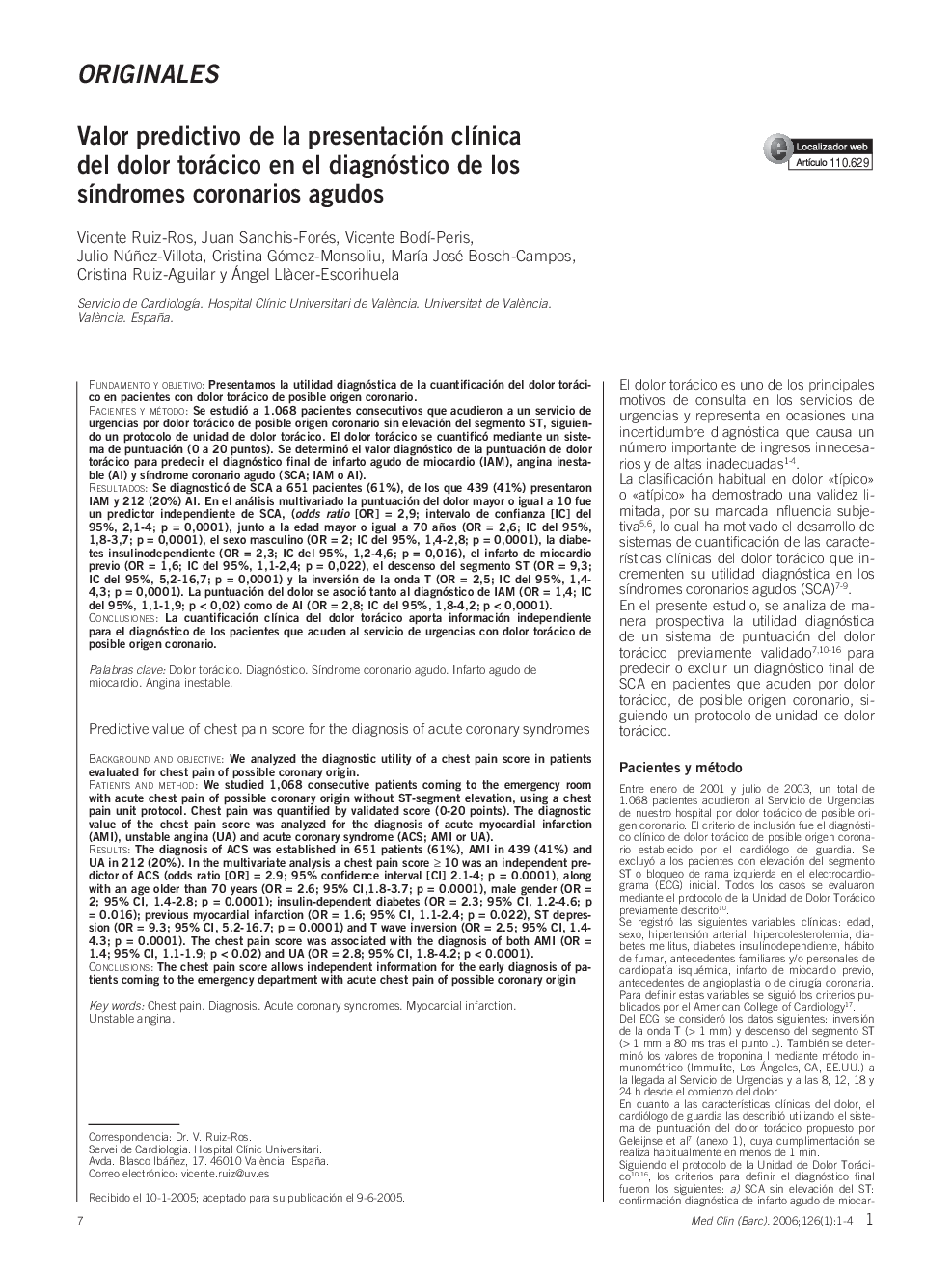| کد مقاله | کد نشریه | سال انتشار | مقاله انگلیسی | نسخه تمام متن |
|---|---|---|---|---|
| 3803465 | 1244910 | 2006 | 4 صفحه PDF | دانلود رایگان |

Fundamento y objetivoPresentamos la utilidad diagnóstica de la cuantificación del dolor torácico en pacientes con dolor torácico de posible origen coronario.Pacientes y métodoSe estudió a 1.068 pacientes consecutivos que acudieron a un servicio de urgencias por dolor torácico de posible origen coronario sin elevación del segmento ST, siguiendo un protocolo de unidad de dolor torácico. El dolor torácico se cuantificó mediante un sistema de puntuación (0 a 20 puntos). Se determinó el valor diagnóstico de la puntuación de dolor torácico para predecir el diagnóstico final de infarto agudo de miocardio (IAM), angina inestable (AI) y sÃndrome coronario agudo (SCA; IAM o AI).ResultadosSe diagnosticó de SCA a 651 pacientes (61%), de los que 439 (41%) presentaron IAM y 212 (20%) AI. En el análisis multivariado la puntuación del dolor mayor o igual a 10 fue un predictor independiente de SCA, (odds ratio [OR] = 2,9; intervalo de confianza [IC] del 95%, 2,1-4; p = 0,0001), junto a la edad mayor o igual a 70 años (OR = 2,6; IC del 95%, 1,8-3,7; p = 0,0001), el sexo masculino (OR = 2; IC del 95%, 1,4-2,8; p = 0,0001), la diabetes insulinodependiente (OR = 2,3; IC del 95%, 1,2-4,6; p = 0,016), el infarto de miocardio previo (OR = 1,6; IC del 95%, 1,1-2,4; p = 0,022), el descenso del segmento ST (OR = 9,3; IC del 95%, 5,2-16,7; p = 0,0001) y la inversión de la onda T (OR = 2,5; IC del 95%, 1,4- 4,3; p = 0,0001). La puntuación del dolor se asoció tanto al diagnóstico de IAM (OR = 1,4; IC del 95%, 1,1-1,9; p < 0,02) como de AI (OR = 2,8; IC del 95%, 1,8-4,2; p < 0,0001).ConclusionesLa cuantificación clÃnica del dolor torácico aporta información independiente para el diagnóstico de los pacientes que acuden al servicio de urgencias con dolor torácico de posible origen coronario.
Background and objectiveWe analyzed the diagnostic utility of a chest pain score in patients evaluated for chest pain of possible coronary origin.Patients and methodWe studied 1,068 consecutive patients coming to the emergency room with acute chest pain of possible coronary origin without ST-segment elevation, using a chest pain unit protocol. Chest pain was quantified by validated score (0-20 points). The diagnostic value of the chest pain score was analyzed for the diagnosis of acute myocardial infarction (AMI), unstable angina (UA) and acute coronary syndrome (ACS; AMI or UA).ResultsThe diagnosis of ACS was established in 651 patients (61%), AMI in 439 (41%) and UA in 212 (20%). In the multivariate analysis a chest pain score ⥠10 was an independent predictor of ACS (odds ratio [OR] = 2.9; 95% confidence interval [CI] 2.1-4; p = 0.0001), along with an age older than 70 years (OR = 2.6; 95% CI,1.8-3.7; p = 0.0001), male gender (OR = 2; 95% CI, 1.4-2.8; p = 0.0001); insulin-dependent diabetes (OR = 2.3; 95% CI, 1.2-4.6; p = 0.016); previous myocardial infarction (OR = 1.6; 95% CI, 1.1-2.4; p = 0.022), ST depression (OR = 9.3; 95% CI, 5.2-16.7; p = 0.0001) and T wave inversion (OR = 2.5; 95% CI, 1.4- 4.3; p = 0.0001). The chest pain score was associated with the diagnosis of both AMI (OR = 1.4; 95% CI, 1.1-1.9; p < 0.02) and UA (OR = 2.8; 95% CI, 1.8-4.2; p < 0.0001).ConclusionsThe chest pain score allows independent information for the early diagnosis of patients coming to the emergency department with acute chest pain of possible coronary origin
Journal: Medicina ClÃnica - Volume 126, Issue 1, January 2006, Pages 1-4